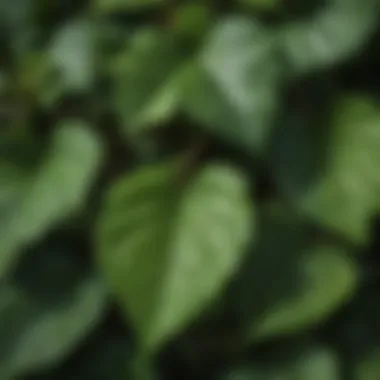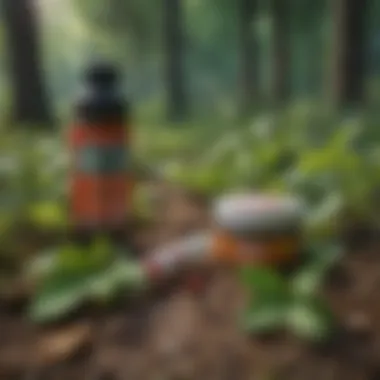Essential First Aid Techniques for Poison Ivy Reactions


Intro
Venturing into wooded areas replete with diverse flora can be a refreshing experience, yet it comes with its own set of challenges. One of the most notorious plants one can encounter is poison ivy. Its oil, urushiol, is sneaky and can trigger uncomfortable allergic reactions in many individuals upon contact. This makes understanding how to manage and treat reactions to poison ivy essential not just for adventurers but also for those involved in forest management and conservation.
Grasping the significance of poison ivy reactions requires insight into both the plant's biology and the body's physiological responses. Navigating this knowledge can empower individuals to make informed decisions when faced with potential exposure. Additionally, being equipped with effective first aid methods can not only save time and effort in soothing discomfort but also aid in the larger context of woodland stewardship.
Throughout this comprehensive guide, we will dig into the anatomy of poison ivy, analyze the physiological responses it prompts in the human body, and explore actionable first aid treatments. Furthermore, we’ll cover strategies to minimize the risk of future encounters with this plant, making sure both novice explorers and seasoned practitioners have the tools they need to safely enjoy the beauty of our woodland ecosystems.
The aim is to simplify complex information and tailor it for both forestry professionals and academics keen on enhancing their knowledge of forest safety practices and ecological awareness. We’ll ensure to highlight the broader implications that understanding poison ivy holds for managing and preserving our precious forests.
Stay with us as we traverse through essential poison ivy first aid techniques and protective measures while appreciating what our forests offer.
Understanding Poison Ivy
Understanding poison ivy is paramount for anyone who ventures into wooded areas or natural surroundings where such flora may lurk, often unnoticed and hiding in plain sight. The significance of grasping the nuances of this plant extends far beyond just knowledge; it is about fostering a respect for our environment and ensuring one’s personal safety.
Botanical Characteristics
Botanically speaking, poison ivy is recognized as Toxicodendron radicans, a name that doesn’t quite roll off the tongue for most but is essential to know for proper identification. This plant typically grows as a climbing vine or shrub, characterized by its distinctive three-leaf structure — often summed up in the phrase, "Leaves of three, let it be." Its leaves can vary in size, shape, and color throughout the seasons. During spring, the leaves appear glossy and vibrant green, transitioning to a more subdued green in summer, and then assuming yellow or red hues in the fall. Furthermore, the plant bears small greenish-yellow flowers and clusters of white berries that provide food for birds and other wildlife.
The notorious reaction it causes is due to an oil called urushiol, which is found in all parts of the plant, including the leaves, stem, and roots. When someone brushes against the plant, urushiol can directly penetrate the skin and trigger a wide array of allergic responses, making understanding its characteristics essential for minimizing risks.
Habitat and Distribution
Poison ivy can be found almost throughout North America, thriving in diverse environments ranging from forests to backyards. It prefers areas with partial shade and moisture but can also adapt to direct sunlight, which makes it an opportunistic plant. You will often spot it along trails, roadways, and near water sources, where the edges of woodland meet. Its adaptability coupled with a propensity for rapid growth can make it difficult to eradicate once established. Being aware of its habitats—like sandy soils or riverbanks—can aid in recognizing its presence more swiftly.
The Psychology of Exposure
Exposure to poison ivy has a psychological dimension worth discussing. Many people experience heightened anxiety when entering environments known to harbor this plant, often leading to caution, vigilance, or even avoidance. This anxiety can sometimes result in overreactions—think of the individual who, discovering a rash, links it to every possible exposure rather than assessing their environment realistically. This tendency illustrates the concept of exposure therapy, where fear of the unknown can impede one's appreciation for nature.
Moreover, an understanding of psychological responses can help in educating others about the risks associated with poison ivy. By demystifying its presence and equipping individuals with knowledge, we can foster a healthier relationship with woodland exploration. The goal is to not shy away from nature due to fears, but to engage with the right awareness.
Knowledge about poison ivy is not just a matter of botanical interest but a crucial aspect of outdoor safety and stewardship.
In summary, understanding poison ivy—from its physical description to its ecological preferences and psychological impacts—equips individuals with important tools for navigating the great outdoors safely. This awareness not only facilitates informed exploration but fosters respect for our natural ecosystems.
Identifying Poison Ivy Exposure
Identifying exposure to poison ivy is a significant part of managing this common nuisance for those who venture into wooded areas. Recognizing the signs of an allergic reaction quickly can drastically affect the severity of discomfort experienced. Understanding specific symptoms and differentiating poison ivy from similar plants saves time and reduces further irritation. For anyone who spends time outdoors, this knowledge is not just practical; it's vital for maintaining a healthy and enjoyable experience in nature.
Common Symptoms of an Allergic Reaction
Poison ivy is notorious for causing a reaction, but not everyone realizes just how distinct those symptoms can be. Here are the common signs to watch for if you suspect exposure:
- Itching: Often the first indication, this relentless itch can drive a person up the wall. It may begin subtly and escalate quickly.
- Redness and Swelling: The area where the skin has come in contact may turn red and swell, leading to the telltale raised bumps that are often mistaken for insect bites.
- Blisters: These fluid-filled pockets appear as the body's immune response kicks into overdrive, offering visual confirmation of the allergic reaction. Blisters can ooze and become crusty if not treated.
- Rash Appearance: A blistering rash is usually concentrated around the area of contact and might spread if you do not properly wash your hands or clothing afterward.
Recognizing these signs early on can be immensely helpful. As the adage goes, "A stitch in time saves nine." Essentially, prompt recognition allows for quicker action, potentially minimizing the reaction's severity.


Differentiating Between Poison Ivy and Similar Plants
Understanding how to distinguish poison ivy from its lookalikes is essential, especially since many individuals may unintentionally come into contact with similar plants. Common culprits include poison oak and poison sumac. Here are key identifiers:
- Leaves: Poison ivy typically has three leaflets, with the old saying, "Leaves of three, let it be," serving as good advice. They can be smooth or slightly serrated, but they are always in clusters of three.
- Stem: The stem can be hairy and may appear reddish in certain seasons or conditions. Poison oak also features a similar arrangement but usually has rounded leaf edges in clusters of three to five.
- Height and Growth Patterns: Poison ivy tends to grow as a vine, climbing up trees or fences, but can also present as a shrub. In contrast, poison oak often appears more shrubby. Being aware of these growth patterns can keep a keen woodsman out of harm’s way.
By taking time to learn how to accurately identify these plants, outdoor enthusiasts can arm themselves against unwanted rashes and discomfort.
"An ounce of prevention is worth a pound of cure."
Meaning, understanding the plants that surround us is fundamental when diving into nature. Familiarize yourself with these aspects, and you may evade the misfortune many others encounter through ignorance.
Immediate First Aid Responses
When confronted with poison ivy exposure, acting fast is paramount. Immediate first aid responses can significantly mitigate discomfort and prevent further complications from the rash caused by this notorious plant. Knowing how to manage a reaction early on can provide not just relief but also empower individuals to take charge of their own health. These immediate actions lay the groundwork for favorable healing outcomes and long-term management of exposure.
Washing the Affected Area
The very first thing to do after suspecting contact with poison ivy is to wash the affected area with soap and water, ideally within thirty minutes. This task sounds simple enough, however, its benefits can’t be overstated. Why is this so crucial?
- Removes the Urushiol Oil: The resin from the plant, known as urushiol, is the culprit behind the itchy, blistering rash. Cleaning the area promptly can help wash away this oil before it penetrates the skin.
- Prevents Spread: If urushiol remains on the skin, it can easily spread to other parts of the body or to other individuals, exacerbating the situation.
Use lukewarm water and a mild soap to gently scrub the area. A vigorous scrub might irritate broken skin; therefore, a soft touch is better. If soap and water aren't handy, specialized wipes that are designed to remove urushiol can be effective alternatives.
Use of Cold Compresses
After washing the area, applying a cold compress can be immensely beneficial. The soothing effect of cold helps to alleviate the itchiness and reduce swelling. Cold compresses work wonders, acting as an immediate soothing balm. What’s more? They can offer a brief reprieve from discomfort, allowing individuals to go about their day with less irritation.
To create a cold compress, use a clean cloth soaked in cold water or filled with ice cubes. Key considerations include:
- Avoid applying ice directly to the skin. Wrapping it in a cloth prevents frostbite.
- Limit cold application to 10-15 minutes, giving the skin time to return to normal afterward.
Using cold compresses is a simple yet effective tactic that can be easily integrated into the immediate first-aid response plan.
Topical Treatments for Rash Relief
Once the initial washing and cooling processes have been completed, topical treatments can enhance healing and provide relief. There are several options available, each with unique merits:
- Hydrocortisone Cream: Over-the-counter hydrocortisone cream is effective in reducing inflammation and itching.
- Calamine Lotion: This classic remedy forms a protective layer on the skin and soothes irritation.
- Antihistamine Creams: These can help in calming allergic reactions, especially if the rash is extensive.
When applying these treatments, ensure the area is clean and dry. One note – avoid covering the rash completely with bandages, as air circulation can aid healing.
The culmination of washing the area, applying cold compresses, and utilizing the right topical treatments can make a significant difference in managing poison ivy reactions effectively. Each step builds upon the last, offering a layered defense against the discomfort and potential complications roused by this ubiquitous plant.
Medical Options for Severe Reactions
When facing severe reactions to poison ivy, medical options are vital for managing symptoms effectively. These reactions can often lead to complications, making it imperative to seek professional help. Individuals who experience severe allergic responses may find themselves grappling with extensive skin rashes, itching, or even respiratory distress. In such situations, having a toolkit of medical interventions becomes not just beneficial but essential. The right options can alleviate discomfort and reduce the risk of long-lasting health issues.
Over-the-Counter Antihistamines
Over-the-counter antihistamines play a critical role in managing mild-to-moderate symptoms associated with poison ivy exposure. Popular medications like diphenhydramine (commonly known as Benadryl) or cetirizine (Zyrtec) can help. These drugs work by blocking histamine, a substance your body produces during an allergic reaction. The relief they provide is noteworthy, especially for itchiness and swelling.


- Benefits:
- Immediate Relief: Many people will notice a significant reduction in itching just after taking these medications.
- Availability: You can easily find these medicines at a local pharmacy without a prescription.
- Affordable: Generally cost-effective solutions for those combating allergic symptoms.
However, potential side effects come along too. Drowsiness is a common issue with many antihistamines like diphenhydramine, which can impair coordination. Therefore, it is recommended to avoid driving or operating heavy machinery until you know how the medication affects you.
Prescription Medications
For more severe cases where over-the-counter options fall short, prescription medications may be necessary. Corticosteroids are often the first line of treatment in these scenarios. They work by reducing inflammation and suppressing the immune response, thus easing the severe symptoms. Common prescriptions include prednisone or hydrocortisone.
- Considerations for Use:
- Duration of Treatment: Generally, corticosteroids are prescribed for a short duration. Long-term use can lead to side effects which might outweight the benefits.
- Doctor’s Guidance: It's pivotal to consult a medical professional to determine the appropriate dosage and length of treatment.
- Follow-up: Regular follow-up appointments might be necessary to monitor your progress and adjust treatment plans accordingly.
"Taking immediate action and knowing the right treatment options can turn a nasty experience into a manageable one."
With proper precautions and awareness, you can safeguard your health and enjoy the great outdoors without fear.
Preventive Measures
When venturing into areas where poison ivy thrives, understanding preventive measures can be the line between an enjoyable outdoor experience and a painful ordeal. Engaging with nature without falling victim to poison ivy involves a mix of awareness, preparation, and vigilance. Implementing effective preventive strategies not only safeguards one’s own well-being but also fosters a respectful attitude towards forest ecosystems.
Reinforcing Awareness of Toxic Plants
The first line of defense against poison ivy is education. Reinforcing awareness involves recognizing what poison ivy looks like and understanding its common habitats. This can be as simple as noting that it typically features leaves with three distinctive leaflets, often with a glossy appearance. Informal sessions that teach about toxicity can be very beneficial, especially for novice woodland explorers.
- Observation skills: Engage in community workshops to familiarize yourself with local flora. Learning how to distinguish poison ivy from non-toxic plants fosters a safe exploration mindset.
- Signage and Communication: Parks and wooded areas can benefit from clearly marked educational signs detailing the appearance of poison ivy, including images. Community outreach through social media may help spread awareness. You can also bookmark resources like Wikipedia or Britannica to continually refresh your knowledge about toxic plants.
- Local groups: Join local hiking or gardening clubs that focus on native plants, and engage in discussions about poison ivy’s habitat and characteristics.
Through a combination of visual awareness and community engagement, we can cultivate a culture that respects and understands toxic plants. This knowledge is not just academic; it must be shared and practiced.
Appropriate Clothing and Gear for Outdoor Activities
Choosing the right clothing and gear is equally critical when trying to avoid coming into contact with poison ivy. Being proactive means investing in protective apparel that can limit skin exposure.
- Cover Up: Long-sleeved shirts and long pants made from thick fabrics are ideal for preventing skin contact. Materials like denim or canvas are less likely to allow oils from the plant to penetrate.
- Footwear Matters: Waterproof boots that cover the ankles can act as barriers against accidental brushes with poison ivy. Fashion is secondary to functionality in these cases.
- Gloves and Gear: When gardening or participating in outdoor work, always wear gloves. Even if you think you recognize the plant, it’s wise to avoid any skin contact. Consider carrying an easily accessible first aid kit with antihistamines or topical treatments within all outdoor activities.
“Good preparation is the key to enjoying the great outdoors.”
In summary, leveraging awareness and adopting prudent clothing choices can significantly reduce the risk of poison ivy exposure. People with heightened awareness and the right preparations can frolic in the woods worry-free—except perhaps about whether they may run into a bear or get lost!
Impact of Poison Ivy on Ecosystems
Understanding the impact of poison ivy on ecosystems requires a closer look at its roles within its native habitat. Though often perceived negatively due to its allergenic properties, poison ivy possesses ecological significance that cannot be dismissed. This section elucidates on how this plant contributes to the vitality of forests and the environmental tapestry around it.
Ecological Roles of Poison Ivy
Poison ivy serves multiple roles within ecosystems, ranging from soil stabilization to supporting local wildlife. Here are some key points:
- Soil Erosion Control: The extensive root system of poison ivy helps in anchoring soil. This is critical in preventing soil erosion, particularly in regions that are prone to runoff and landslides. The plant's deep roots create a natural barrier that can fortify slopes and embankments.
- Biodiversity Support: Poison ivy is not merely an obstinate weed; it plays a part in biodiversity by offering habitat and food for a variety of organisms. Its berries are a food source for birds, who consume them and later disperse the seeds, aiding in the plant’s propagation.
- Nurturing Microhabitats: The dense growth of poison ivy can offer shelter for small mammals and insects. This microhabitat can be crucial for animal reproduction and survival, particularly in areas where suitable nesting sites might be limited.


Poison ivy, while controversial, thus contributes positively to the ecological framework, which highlights the importance of understanding its role in the environment rather than merely vilifying it.
Interactions with Wildlife
When considering how ecosystems function, one cannot overlook the interactions between poison ivy and wildlife. These interactions are both complex and essential to maintaining environmental balance.
- Food Web Dynamics: Various birds, such as the American Robin and Eastern Bluebird, rely on poison ivy fruit, particularly in late summer and fall. These birds do not just feast; they help in spreading the seeds across their range, effectively propagating the plant throughout the region, which can lead to increased growth in appropriate areas.
- Insect Habitats: Many insects find refuge in poison ivy. For instance, certain butterflies and moths utilize the leaves as larvae food. The presence of poison ivy can thus influence the dynamics of insect populations, providing sustenance that fosters diverse insect communities, which in turn serve as prey for birds and small mammals.
- Influence on Herbivore Behavior: Interestingly, various herbivores tend to avoid consuming poison ivy due to its urushiol oil, which is the culprit behind the rash in humans. This avoidance shapes foraging patterns in wildlife and may aid in the propagation of less palatable plant species in the vicinity.
In summary, poison ivy might invoke a sense of dread for some, but it is a key player in the ecological drama, supporting food webs and contributing to the health of its surroundings. Understanding these interactions enriches our appreciation for the complexities of the ecosystem and highlights the necessity of education surrounding plants often stigmatized in public discourse.
Cultural Perspectives on Poison Ivy
Understanding the cultural context around poison ivy is key to grasping its multifaceted role in human experience. Often viewed in a negative light due to its notorious ability to induce a painful rash, poison ivy is more than just an adversary in the woods. It carries historical, medicinal, and symbolic weight that varies across different communities. By exploring these cultural perspectives, we can better appreciate the intricate relationship between humans and this resilient plant.
Historical Uses and Misunderstandings
Though generally labeled as a nuisance, poison ivy has had various historical uses that shed light on human ingenuity and resourcefulness. Indigenous tribes utilized parts of the plant for medicinal purposes, employing its sap to treat ailments like poison ivy rash itself or as a remedy for skin issues. This demonstrates not just a pragmatic approach but also a profound respect for nature.
However, misunderstandings prevail. People often perceive poison ivy purely through the lens of its toxicity, ignoring its potential benefits. For example, some herbal traditions still recognize this plant's properties, aiming to harness its characteristics for healing rather than just avoidance. The narratives shaped by folklore and personal experiences can skew perceptions, leaving many unaware of its possible medicinal value.
Key Historical Misunderstandings of Poison Ivy:
- Toxicity: Often mistaken for other plants, leading to misidentified risks and remedies.
- Exclusivity of Experience: Many assume only certain individuals react negatively, when in reality sensitivity varies widely.
These historical contexts need revisiting, as they essential insights can lead to greater appreciation and understanding of poison ivy’s role in our ecosystems—both ecological and cultural.
Symbolism in Folklore and Nature
In terms of symbolism, poison ivy figures prominently in various cultural narratives, representing both caution and resilience. In many tales, it serves as a reminder of nature’s boundaries; a warning to tread lightly and respect the wild. This symbolism amplifies the notion that nature harbors beauty and danger in equal measure, a common theme brought to life in folklore.
Furthermore, poison ivy is often linked to concepts of growth and adaptability. Despite its harmful attributes, the plant thrives in a myriad of environments, reflecting traits of perseverance and strength. For someone observing the plant in its natural habitat, there’s a note of humility to be found in recognizing how something perceived as negative can possess undeniable beauty and functional importance in local ecosystems.
"In nature, what may appear harmful at first often supports deeper truth and harmony within ecosystems."
Indeed, poison ivy might just symbolize life's complexities, serving as a metaphor for overcoming obstacles and embracing the unseen connections in nature. This cultural significance enriches the narrative around poison ivy, shifting the view from one of mere avoidance to understanding its broader ecological roles.
In summary, shedding light on cultural perspectives regarding poison ivy reveals its historical uses, misunderstandings, and symbols, all of which remind us that even the most troublesome plants can hold storied pasts and valuable lessons.
Understanding these perspectives could foster a healthier respect for our environment and a deeper connection to the natural world.
End
Understanding and effectively responding to poison ivy exposure is not just a matter of comfort, but also a vital aspect of outdoor safety. The handling of this ubiquitous plant goes beyond simple first aid responses; it intertwines with awareness, education, and a respectful approach to the ecosystem. As we explored throughout this guide, the physiological reactions to poison ivy can range from mild irritation to severe discomfort, and how you react in the crucial moments can significantly alter your experience outdoors.
Summary of Key Points
- Identifying Symptoms: Familiarizing yourself with the symptoms of poison ivy exposure is paramount. Recognizing the difference between various skin reactions can lead to quicker and more effective treatment.
- Prompt First Aid: Immediate actions, such as washing the affected area and applying cold compresses, should be prioritized. Knowledge of specific topical treatments can greatly reduce discomfort and speed up recovery.
- Medical Options: For severe allergic reactions, gauging when to seek medical help can mean the difference between a manageable situation and a medical emergency.
- Preventive Measures: Awareness of one's surroundings, the importance of appropriate gear, and ongoing education are essential in mitigating the risk of exposure.
The Importance of Education and Awareness
It is crucial to emphasize the role of education in combatting the misunderstandings around poison ivy. Many individuals harbor misconceptions about this plant, which leads to avoidable exposures.
- Community Awareness: Spreading knowledge within communities, especially among outdoor enthusiasts, can foster a culture of caution and respect for nature. Organizing workshops or informational sessions can enhance understanding and proactive behaviors.
- Ongoing Education: For professionals working in forestry or environmental management, continuous education about toxic plants like poison ivy can significantly reduce incidents. Familiarity with proper identification and prevention strategies ensures not only personal safety but also the well-being of those they work with.
"Education about nature’s risks, like poison ivy, is as essential as knowing its wonders."







